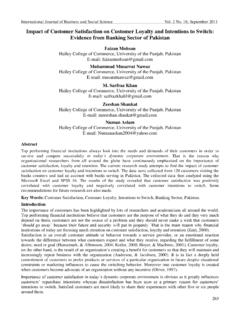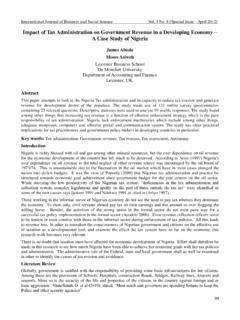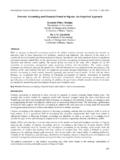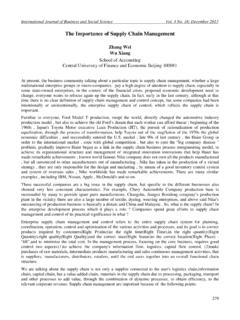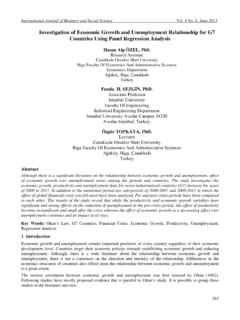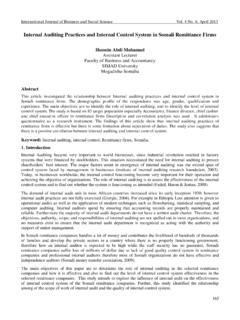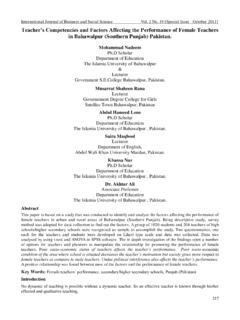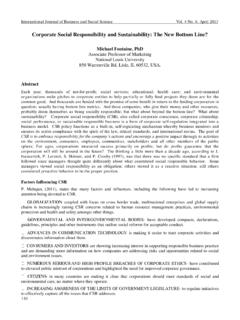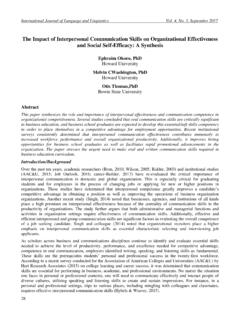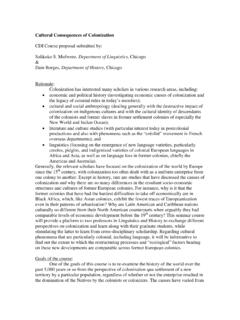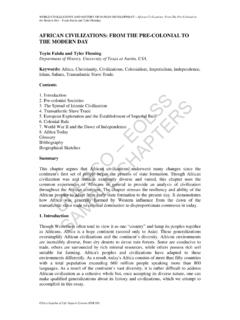Transcription of How Culture Affects on English Language Learners’ (ELL’s ...
1 International Journal of Business and Social Science Vol. 3 No. 5; March 2012. How Culture Affects on English Language Learners' (ELL's) Outcomes, with Chinese and Middle Eastern Immigrant Students Ani Derderian-Aghajanian Wang Cong Cong Washington State University United States of America Abstract Immigrant English Language Learners' (ELL's) differ according to Culture , and therefore may face different challenges, stereotypes, etc. Chinese and Middle Eastern immigrant ELL's face challenges in the following main areas: linguistics, Culture and academy. However, other factors such as stereotypes of immigrant students also challenge them in English literacy acquisition. In addition, students from different types of immigrant families may be confronted with different challenges. Accordingly, the main question of this paper is What are immigrant English Language learners' main challenges related to English literacy acquisition?
2 Sub-questions include What challenges do ELL students from different immigrant cultures face? and What methods help students from immigrant families with English literacy development? This paper explores past research on these questions as well as educational implications. This comparison study highlights the Chinese and Middle Eastern cultures as two examples to how Culture Affects ELL outcomes, cultural differences in parental knowledge and education, and socioeconomic issues. This qualitative study uses in-depth interviews with two Middle Eastern and two Chinese students. The results show the challenges that these students face. The paper concludes with recommendations on how schools and teachers can better respond to the needs of Immigrant EEL students from different cultures. Keywords: Culture , English Language Learners', Chinese and Middle Eastern immigrants Stereotypes leading to challenges With the rapid increase in Chinese immigrants in Canada as well as the United States, students from immigrant Chinese families are becoming a significant segment of the North American school population.
3 Contemporary public perceptions of Chinese and other Asian students are based on reports of these students' high test scores and academic success in comparison with other minority groups, such as African and Hispanic students in the United States, and Aboriginal students in Canada (Li, 2003). As a result, immigrant Chinese learners are often stereotyped as high achievers who are joyfully initiated into North American life and English literacy practices and overlooked in literacy research (Li, 2004, p. 31). According to Palmer, Chen, Chang, and Leclere (2006), as with any stereotyping, Chinese students often encounter the bias perpetuated by the "myth of the model minority.". Many Americans mistakenly assume that all Chinese students come to their country with special academic skills and acumen. However, according to Li (2003, 2004), and Lee (1996), this stereotype is dangerous because it promotes invisibility and disguises the social realities of many other children from different families and socio- cultural contexts.
4 As Li (2003) indicates, we are prevented from unraveling the social realities of those who face problems in educational system as well as the problems many Chinese children face in and out of school ( , sociocultural barriers, Language differences, and poverty). Li (2003) further indicates that the school failure of some immigrant Chinese students suggests that these children, while bearing the negative impact of model minority stereotypes, also face different sociocultural, socioeconomic, and sociopolitical challenges. Thus, Lee (1996) and Li (2002, 2003) suggest researchers pay more attention to individual and differential achievement, especially for the under-achieving Chinese students within this population. According to Fu (2003), lacking the content knowledge needed for American education, many Chinese immigrant students have limited English proficiency, no parental support at home for their school work, and need to make tremendous adjustments emotionally, socially, culturally, and academically in their new lives in America.
5 These are all the main challenges that stereotypes bring to Chinese immigrant students in English -speaking countries. 172. Centre for Promoting Ideas, USA Middle Eastern Students Stereotypes and Challenges The increased internationalization of education has an important impact on the Middle Eastern immigrant students learning outcome (Mahrous & Ahmed, 2010). In Taking Terrorism into the Classroom, Linda Fuller questions the relationship between international terrorism, media and learning. She notes that terrorism has dominated the media, with increasing emphasis since 9/11. A teacher herself, Fuller uses role playing in the classroom to explore the new stereotypes of Middle Eastern people and the challenges that Middle Eastern students face in American schools. She noted that after this exercises, students became more open with each other, and were able to see how the media had influenced their past assumptions about students from other cultures (Fuller, 1991).
6 Arab Americans in schools represent more than 20 countries in the Middle East and Northern Africa. They share many similarities with other immigrant groups seeking to establish an ethnic identity in a heterogeneous country, but they also face additional challenges. These result especially from negative stereotyping; racism and discrimination; widespread misinformation about their history and Culture ; and, for the majority who are Muslim, the need to find ways to practice their religion in a predominantly Judeo-Christian country (Jackson, 1995). The previous quote reveals race, religion, and Culture discrimination towards immigrant Middle Eastern students (Earnest, Joyce, Mori, & Silvagni, 2010). These negative stereotypes affect on the students achievements and self esteem in the American schools. Thus, in order to better understand these differences it is recommended to know about these students' Culture and history.
7 Literacy, Culture and Schooling Challenges Related to Culture Differences Literacy is grounded in specific cultural values (Li, 2003). Li indicates that immigrant Chinese students' literacy and life ways, embedded in heritage cultural values, are not congruent with the school Culture which confirms that cultural discontinuity explains, in part, widespread minority school failure. As Packard (2001) indicates, children from immigrant Chinese families experience an intergenerational, intercultural gap with parents in terms of Language and traditions. In Li's study (2003), the immigrant Chinese student participants' conception of what it means to be literate was rooted in the traditional Chinese philosophy that emphasizes the ability to read classic literature. This belief was different from the Canadian school practice of using children's picture books to help foster their children's interest in reading.
8 A study by Zhang, Ollila and Harvey (1998) adopts a socio-cultural perspective which defines literacy in cultural terms and views children as becoming literate within the cultures of their communities and their families. They point out that cultural background is an essential aspect of personal identity that interacts with the education one receives in a certain society, because values advocated in the Canadian education system may not be consistent with Chinese cultural and educational values. Immigrant Chinese parents in Canada may transmit messages about expectations and educational success to their children which differ from the messages these children receive in school. Thus, the literacy development and schooling of immigrant children should be examined within the socio- cultural context of Canada and the context of the home Culture in which the parents and students were raised.
9 Differences in Education Differences in education between an English -speaking country such as the and China bring another challenge to Chinese immigrant English Language Learners. Palmer, Chen, Chang, and Leclere (2006) indicate three educational differences in learning styles, teacher/student-centered teaching, and explicit/implicit learning. First, comparing with English -speaking learners, Chinese learners require a large number of facts to be committed to memory (Li, 2002). This difference reflects the unique characteristics of Asian cultural concepts of literacy acquisition. Second, Chinese students are accustomed to teacher-centered classrooms in their home country. By contrast, teachers in the are more student-centered with teacher-student and student-student interactions being the norm. Third, by citing a saying Master 300 Tang (Tang Dynasty) poems, and you become a poet yourself, they also indicate implicit learning used by Chinese speaking students.
10 Similarly, Zhang, Ollila, and Harvey (1998) indicate that a main difference between Chinese and Canadian education is, that traditionally, in Chinese schools, content and curriculum are often standardized across the nation. In Canada, teachers provide guidance only; learning is open and at the initiative of individual students. This difference also leads to challenges for immigrant Chinese students. 173. International Journal of Business and Social Science Vol. 3 No. 5; March 2012. In recent years, researchers have concluded that minority students' school failure may be the result of the mismatch between learners' primary discourse of home and the secondary discourse of school, including differences in Language , literacy beliefs, and interactional patterns (Li, 2003). As familiarity with school literacy discourse is the mark of school success, students from non-mainstream cultural backgrounds have to learn a different set of conventions of literacy practices and often experience difficulties with schooling (Li, 2003).
